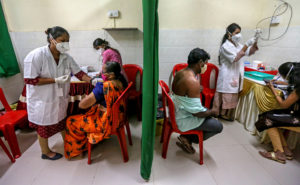INDIA’S NEW COVID-19 VACCINE POLICY
Relevance: mains: G.S paper II: Polity: Schemes and policies & Current Affairs

Context:
It seems certain that many recipients will pay more than in the first three phases of vaccination, but key questions about availability, distribution, prioritisation remain unanswered. Here’s what is known so far
Why in news?
India will dramatically expand its vaccination coverage from May 1, including everyone aged 18 and older. The fourth phase of the mass inoculation programme incorporates several changes in vaccine policy.
What are the changes in procurement?
- In the first three phases, when healthcare workers, frontline workers, and those above the age of 45 were vaccinated, the Centre procured the entire quantity of vaccines from the manufacturers, Serum Institute of India (Covishield) and Bharat Biotech (Covaxin), and distributed it to states.
- The states distributed the stock to government vaccination centres, which administered the vaccine free of cost, and to private hospitals that charged recipients Rs 250 per dose.
States will receive doses from the Centre and also make additional procurement from the open market — so how will they plan vaccination sessions?
How will the Centre decide which state gets how many doses?
- The Centre will allocate its 50 per cent share to states based on the extent of infection (active cases) and performance (speed of administration).
- Currently, states receive vaccine doses according to demand (number of registrations and walk-in vaccinations). Now, low wastage will be incentivised.
Will imported vaccines also be divided among the Centre, states, and private hospitals?
- The Centre will allow the imported, fully ready-to-use vaccines to be entirely utilised in the other-than-Government of India channel.
- Thus, if and when a foreign pharma giant brings its vaccine to India, it will be free to directly sell the entire stock in the open market at a competitive price.
Will those who have received the first dose — and whose second dose is due — be prioritised?
- The Centre said that the second dose of all existing priority groups, “wherever it has become due, would be given priority, for which a specific and focused strategy would be communicated to all stakeholders”.
How will manufacturers apportion their quota for states? Which states will get first, and more?
- Again, there is little clarity on the mechanism that manufacturers will employ to decide among states that place orders. And in the absence of a formula or guidelines, passing control over to private vaccine producers will mean that there will be no social basis for allotting vaccines to states.
- Only commercial considerations are likely to prevail. States will compete for a fixed quantity of vaccines, which will continue to be in excess demand.
- Private companies would prioritise selling at Rs 600 per dose and not Rs 400 per dose. This means that selling to states will be less of a priority for vaccine producers than to private hospitals. States are likely to be squeezed as a result.
- That said, however, it is likely that manufacturers will follow the Centre’s lead in prioritising — and states with high caseloads will be put ahead in the queue.
Could it be first-come, first-served?
It would depend on how many states enter into deals with manufactures, and on the availability of doses. Richer states, which have the ability to procure large amounts, and states with large networks of private hospitals, are expected to receive a higher proportion of doses from the open market.
Which other countries in the world have allowed open-market sale of vaccines?
- None so far. The main reason is that the vaccines that are being used around the world have received only Emergency Use Authorisation (EUA) — none of them have presented enough evidence yet on their safety and effectiveness to receive full regulatory authorisation.
- Under normal circumstances, it might take 8-10 years to develop, test, and receive approval for a vaccine. But in this extraordinary pandemic scenario, the development, clinical trials, and approvals have been fast-tracked to ensure that people have a chance at escaping severe disease or death.
- No other country is doing this (open market sale) as yet, because all these vaccines are still under restricted or emergency use permissions and have not yet been fully licensed in their countries of origin, except, perhaps, in Russia.
Given the public health priority of vaccinating a large segment of their populations, several countries, including the US, UK, Japan, France, and China, are providing vaccines for free to citizens.
Once an estimated 600 million new recipients become eligible on May 1, when and from where will the required stocks of vaccines be procured?
- Some 130 million shots have been administered in India so far, and over 111 million people are yet to receive their second dose.
- Depending on how many people in the priority groups are still left to receive their second shot by the time May 1 comes around, the country could need over 1.2 billion doses of vaccines.
- Given the country’s current production capacity and the delay in bringing in foreign vaccines, supply will almost certainly fall short of demand.
SII is going to prioritise doses of Covishield for India “at least” for the next two months, which means a potential supply of around 120 million to 140 million doses will be available for the country between May and June. However, the company is expecting to begin to deliver for the open market only from the third or fourth week of May.
Sputnik V is expected to begin arriving in the country by the end of May. Dr Reddy’s Laboratories has an agreement to distribute 250 million doses of the Russian vaccine, but it is unclear how many of these doses may become available to India. The company is still in discussions with the government over the price and number of doses required.

